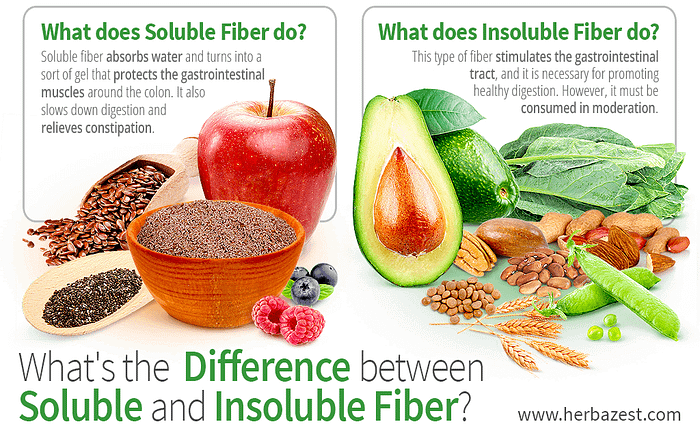Soluble vs Insoluble dietary fiber

Following our webinar on “how to boost immunity” where we discussed fibre & what role it plays in boosting immunity, today we are going to discuss in detail about types of dietary fiber.
Dietary fiber is part of plant based food that passes through your digestive system without being digested. There are two types of fibers: soluble & insoluble.
Soluble fiber dissolves in water & includes plant pectin & gums. On the other handle insoluble fiber does not mix with water & consists of plant cellulose & hemicellulose. Most plants contain both soluble & insoluble fiber albeit in different amounts. Fiber is an essential part of our diet & plays an important role in various body systems.
Soluble & Insoluble fiber both have inherent benefits.
As soluble fiber dissolves, it gets converted into gel which improves our digestion. It also helps in controlling cholesterol & sugar. Since you feel full after consuming fiber, it reduces your food cravings & controls the glucose/carbohydrates you consume essentially reducing the risk of diabetes.
On the other hand insoluble fiber supports insulin sensitivity. Besides, it attracts water into stool making it easier to pass through the bowel, creating less strain on the bowel. It helps in improving our gut health & keeping gut health. Like soluble fiber, insoluble fiber reduces the risk of diabetes. The perfect amount of dietary fiber helps in:
- Controlling weight
- Prevent hypertension
- Helps balance cholesterol
- Regulate bowel movements & prevent hemorrhoids.
- Keep your body full thereby reducing sugar & food cravings
- Requires more chewing which helps in digestion
- Lower risks of breast & colon cancer
Consuming too much fiber can cause gas, pain & abdomen bloating. It is recommended that you increase your fiber intake slowly. It is important that your fiber intake should be accompanied by water in order to maximize benefits from fiber consumption.
Your diet should have a lot of fruits, vegetables, legumes, and grains to have a fiber rich diet. Please consider the following while choosing foods rich in dietary fiber:
- Canned foods have less fiber than fresh & whole foods.
- Plant has a variety of soluble & insoluble fiber as discussed above. It is therefore recommended to have a lot of fruits, vegetables & whole grain foods. 50% of your meal plate should consist of green veggies & whole grains.
We are sharing some good sources of both soluble & insoluble fiber.
Good sources of soluble fiber:
- Oats
- Peas
- Beans
- Apple
- Citrus fruits
- Carrots
- Barley
Good sources of insoluble fiber include,
- Whole wheat flour
- Nuts
- Cauliflower
- Green Beans
- Beans
- Wheat bran
Click here to know how I started my own fitness brand Passion for Fitness
We’re offering online fitness coaching to folks around the world who do not have time to go to gym or take care of their health despite their location or geography. This isn’t just a regular online personal training, but will be a lifestyle change for you that can be embraced forever.
We believe in empowering fitness aspirants by offering them DIY learning about their body, metabolism, nutrition & calisthenics based workout to train their muscles using body weights, so that they’re able to sustain transformation post completion of the program.
Experience first & then pay, get a free trial for 7 days. No card required.
Sign Up here.
PS: Originally published on www.thesushantkumar.com